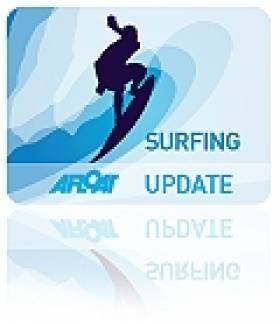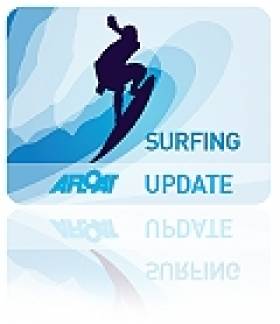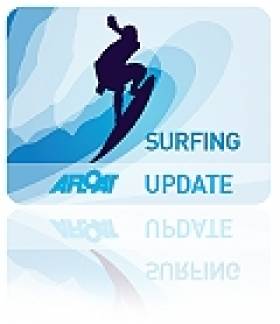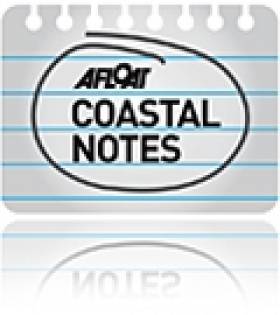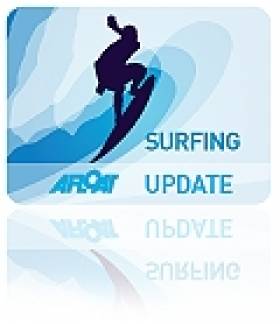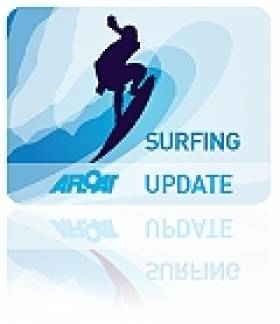Displaying items by tag: Surfing
Surfers On Standby for Third Big Wave Tow-in Session
#SURFING - Some of the world's best big wave surfing stars are making their way to Ireland again this winter to compete in the third annual Billabong Tow-In Session.
The waiting period for the event started on November 1 and finishes on March 1. Organisers only need one day of giant waves at Mullaghmore in Co Sligo to stage the event.
And as reported yesterday on Afloat.ie, this weekend could produce some big results as growing swells in the Atlantic combine with southerly winds.
Last year's event was cancelled because the required waves in excess of 20 feet failed to arrive during the four-month waiting period.
The inaugural event in 2010, however, saw competitors taking on 20-30 foot waves at Mullaghmore, a break that is fast gaining a reputation as one of the most fearsome and best big wave locations in the world.
"Mullaghmore is an incredible wave, one of the heaviest I've surfed and one that holds unlimited potential for giant waves," said the 2010 winner Benjamin Sanchis from France.
Sanchis and his partner Eric Rebiere have been invited back to defend their title.
Along with the defending champions competitors from Ireland, Hawaii, USA, Great Britain, France, Spain, Germany, Tahiti and South Africa have all been invited.
The runner-up pair from the inaugural event, Peter Conroy (Co Clare) and Glyn Ovens (UK), are among several Irish teams set to challenge the overseas surfers in their home country.
"Mullaghmore is impressive with its grassy headland acting as natural amphitheatre for spectators to watch the event," said Conroy, "but it's a scary place when the surf is big. There's lots water swirling around and surging up from the underwater reef ledges.
"Hopefully this year's event will get great waves and we will all return safely to shore."
Because lives are at stake, only those surfers with recognised big wave experience are invited to compete. Competitors are also expected to be well versed and qualified in all the necessary rescue and water safety procedures.
The event is sanctioned by the Irish Surf Rescue Club and the Irish Surfing Association.
Surfers Swarm on Sligo for Year's Biggest Waves
#SURFING - The Irish Times reports that surfers from around the world are flocking to Sligo in expectation of what might be Ireland's biggest waves of the year.
Breakers of up to 30 feet off Donegal Bay could be the result if growing swells in the Atlantic combine with southerly winds expected from this weekend.
“We have had 50ft waves in the past but 30ft waves would certainly be great and you would have a lot of surfers coming into Ireland to follow them," said top Irish surf pro Richie Fitzgerald.
Elsewhere, President Michael D Higgins made a recent visit to the Somo Surf Centre in Cantabria, northern Spain while attending Spanish courses ahead of his State visit to South America last month, as Oceanlook reports.
“I had already heard of the charms of Loredo and Somo," the President commented. "There are many Irishmen flying to Cantabria in search of sun and also waves to get the chance to surf.”
Surfers Train as Lifeguards in Jersey
#RNLI - In what seems like a perfect match of skills, BBC News reports on a group of five surfers from Jersey who are being trained as lifeguards by the RNLI.
The surfers have graduated from voluntary beach patrols to learning about hazard awareness, accident prevention, first aid and open water rescue skills, according to RNLI lifeguard supervisor Rob Stuteley.
It's hoped that the scheme will "play a big part in encouraging more local people to sign up to join the RNLI lifeguard team for 2013".
And maybe it will provide some inspiration for surfers and lifesavers around the Irish coast, too!
Surfers, Islanders Clash at Doolin Pier Hearing
#COASTAL NOTES - Clare surfers say they have no confidence that development plans for Doolin Pier will not have a negative impact on the Crab Island surf break.
The Irish Examiner reports on an oral hearing on the project held by An Bord Pleanála in Ennistymon on Wednesday morning at which representatives of the Irish Surfing Association and the West Cost Surf Club expressed their fears of losing "the jewel in the crown" of Irish surfing.
As previously reported on Afloat.ie, local surfers have been at loggerheads with Clare County Council over long-delayed plans to redevelop the pier facilities at Doolin, which currently serves more than 70,000 passengers between the Clare coast and the Aran Islands.
At present the pier cannot be accessed at low tide, and foul weather cost the ferry route to 40 days's business last year, the meeting heard.
Island co-op Comhar Caomhán Inis Oírr is among the groups supporting the €8 million development plans, arguing that the islands would be "under threat" if the project does not proceed.
Easkey Britton Praises New Account of Surfing in Ireland
#SURFING - A new book that delves into the world of surfing in Ireland gets a thumbs-up review from surf pro Easkey Britton in The Irish Times.
Cliffs of Insanity, by Irish Times sportswriter Keith Duggan, focuses on the close-knit surfing community in Lahinch, Co Clare - one of the many hotspots along the west coast that have produced such Irish big wave sensations as Ollie O'Flaherty and overseas visitors like Devon's Andrew Cotton (featured in the video above).
Britton - in the news herself recently for her pioneering surf trip to Iran - notes the passion among Ireland's surfers "to pursue a challenging vocation, one that is raw and unglamorous, set against the icy waters of the Atlantic" towered over by the Cliffs of Moher - the 'cliffs of insanity' of the title.
She also describes the book's central story - the progress of Mayo man Fergal Smith and Cornwall native Mickey Smith as they surf the uncompromising Aileens break - as "a story of hope for an island nation on its knees".
"Duggan presents a rare and intimate window into a little-understood world," she writes. "The ocean and the art of wave riding run so deep in our veins that when you ask a surfer to describe what it feels like we struggle to put it into words."
The Donegal surfing star adds that Duggan "is uniquely positioned as an 'outsider' looking in, and he captures what it is that drives these surfing souls, describing it as 'an elemental pull'."
The Irish Times has more on the story HERE.
Surfers To Clash With Council Over Doolin Development
#DOOLIN PIER - The Irish Times reports that surfers will be at loggerheads with Clare County Council this week over controversial plans to redevelop Doolin Pier.
The €8 million plans for the Clare coastal village have been delayed for some time, and have already cost the council more than €250,000.
As previously reported on Afloat.ie, the development was backed unanimously by Clare councillors in March 2011 after revisions made following concerns from local surfers about its impact on popular waves in the area.
However, the Irish Surfing Association (ISA) maintained that even that revised plan would result in the elimination of the waves at Doolin Point and Crab Island - the latter described as Ireland's answer to the Pipeline in Hawaii.
The proposed new pier would serve the 70,000 passengers that use the ferry service between Doolin and the Aran Islands. The development is also supported by the Doolin unit of the Irish Coast Guard, which hopes to get a new coastguard station as part of development plans for the area.
French Surfer Rides the Big One Off West of Ireland
#SURFING - Surfing website MagicSeaweed captured French surf pro Justine Dupont in top form at Aileens off the West of Ireland on Sunday 21 October.
The 21-year-old paddled out to the secret big wave surfing spot with 2011 Billabong XXL Biggest Wave Award winner Benjamin Sanchis, where they promptly broke their boards caught in the biggest barrels of the day.
Turning their attentions instead to the "infamous cold water right-hander", Dupont was towed into a stunning 12-foot tunnel of water - as the video above shows.
"It was more than a session, it was a mission," said Dupont. "From getting smashed paddling out to surfing that perfect beautiful wave, it was a day I’ll never forget."
MagicSeaweed has photos and video of Dupont's Aileens adventure HERE.
Video Shows Surfers Taking On West Coast Waves
#SURFING - WorldIrish brings us another gem of a video as surf pros take on the challenging waves off the west coast of Ireland.
It's just the latest praise for the Emerald Isle as a world-class surfing destination.
Up Close and Personal with NI Big Wave Surfer Al Mennie
#SURFING - Top press photographer Charles McQuillan recently travelled to Northern Ireland to capture big wave surfing pro Al Mennie in training for the winter season, as The Irish Times reports.
McQuillan set out to document every aspect of Mennie's surfing life on the north Antrim coast, from the pre-dawn starts and protein-heavy breakfasts to the gruelling solo training sessions and the thrill of the surf itself.
And he made sure to get up close and personal with his subject, using waterproofing equipment to photograph him underwater - and even following him on a jet-ski to the secret offshore surfing spots known only to Mennie and his fellow big wavers.
The snapper described the surfer as "incredibly at home" in the water. Not surprising for a man used to taking on the enormous Finn McCool swells off the Giant's Causeway, or paddling across the North Channel for charity as he did this past spring (see more pics of Mennie surfing HERE).
As Mennie tells the Belfast Telegraph, he has the good fortune to be able to ride “the biggest, scariest waves on the planet” in his own backyard.
It comes at a price - Mennie must be in peak physical condition at all times, as one never knows when the big one might come - but it's a price he's more than willing to pay, with his body and his mind.
“Big-wave surfing is at least 80 per cent to do with your mind, and the physical aspect boosts the mental side," he tells The Irish Times. "I don’t feel 100 per cent in myself unless I’m training properly.”
Meanwhile, The Irish Times also highlights the best places to get your wetsuit on and go surfing in Ireland during the increasingly popular winter season, with schools in the hotspots of Lahinch in Co Clare - the focus of a new book by journalist Keith Duggan - and Bundoran, Co Donegal upgrading to meet the demand.
And even if its waves aren't up to scratch, the east coast still is getting some of the action, with stand-up paddleboarding (SUP) becoming the latest way to ease into the sport.
Easkey Britton Makes Waves in Iran for New Documentary
#SURFING - A documentary charting Easkey Britton's history-making surfing trip to Iran will premiere on French TV later this month, according to The Irish Times.
The hour-long film was shot by French filmmaker Marion Poizeau during the Donegal surf champion's visit in September last year to Chabahar, a coastal town in southern Iran on the Pakistan border.
Britton - of the northwest surfing dynasty - became the first woman ever to surf in Iran when she donned a full-length 'hijab swimsuit' and took to the waves in near 40 degree temperatures - attracting much attention from the locals.
“Iran is not known as a surf destination," she says, "but experiencing a country through surf gives you a different perspective. It was a leap into the unknown, but I thought I’d give it a go.”
Britton is now hoping to encourage more women and girls in the Middle East to take up surfing, noting its growing popularity in the Gaza Strip.
The Irish Times has more on the story HERE.


























